My neighbor had a citrus tree that she called a grapefruit, but it made curious fruit: it was the size and shape of a grapefruit but the rind was golden yellow, unlike any grapefruit I’d seen, and the flavor was so sweet that it tasted artificial. How could this be a grapefruit?
I brought some to a farmer friend, and the instant he saw the fruit he said, “This is Cocktail.”
“Are you sure?”
He cut out a wedge and tasted it. “This is Cocktail.”
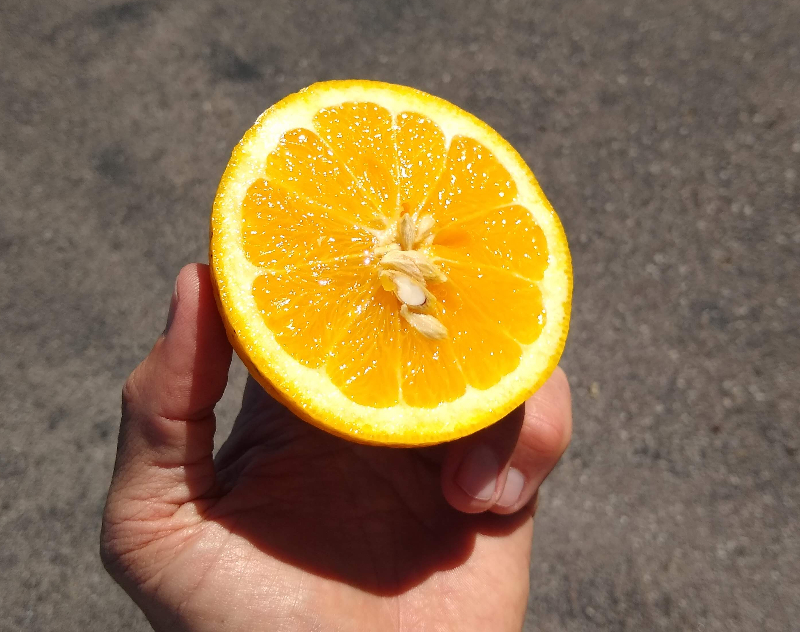
Cocktail’s origins
Afterward, I looked up Cocktail grapefruit, and sure enough, the photos and description matched. But how is it that a grapefruit makes juice so sweet that I nicknamed it Kool-Aid? The answer: it’s not a grapefruit.
According to the entry in UC Riverside’s citrus variety collection, Cocktail is a hybrid between a mandarin and a pummelo (so some people call it a “mandelo”). UC Riverside is probably right on this one, as they also claim that the hybrid was done by one of UCR’s own researchers around the 1950s.
More specifically, the Cocktail variety is said to be a cross between Frua mandarin and Siamese pummelo. “The variety was never officially released by the University of California, Riverside, but somehow made it into the public sector,” it says in the UCR entry. “This hybrid ‘escaped’ into the industry and was named ‘Cocktail grapefruit’ by a citrus nurseryman (probably).”
Cocktail fruit
My own discovery of my neighbor’s fruit happened about ten years ago, and I feel like I rediscover Cocktail again every February. They’re ripe from about now and through March. You can eat them in January and they taste more like grapefruit (less sweet), or you can eat them after March and they taste so sweet that you want to cut their sugar with a more acidic citrus (blood oranges work well for this job, as they add acidity and blood color).
But always, Cocktail fruit is exceedingly juicy. They’re balls of water. And good thing, because they are so choked with seeds that they’re not easy to eat. We rarely eat them; we almost always juice them.
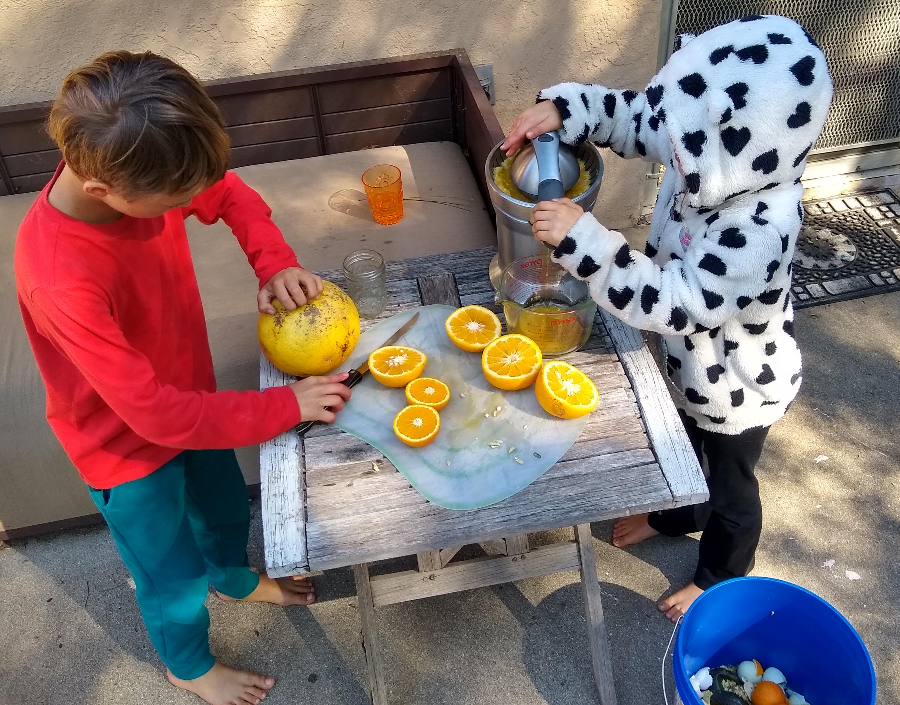
Occasionally, a Cocktail grapefruit will only be the size of a baseball, and occasionally one will be the size of a pummelo (or pomelo, however you like to spell it), but usually they’re the size of a grapefruit. Ha! That is, they’re the size of a softball.
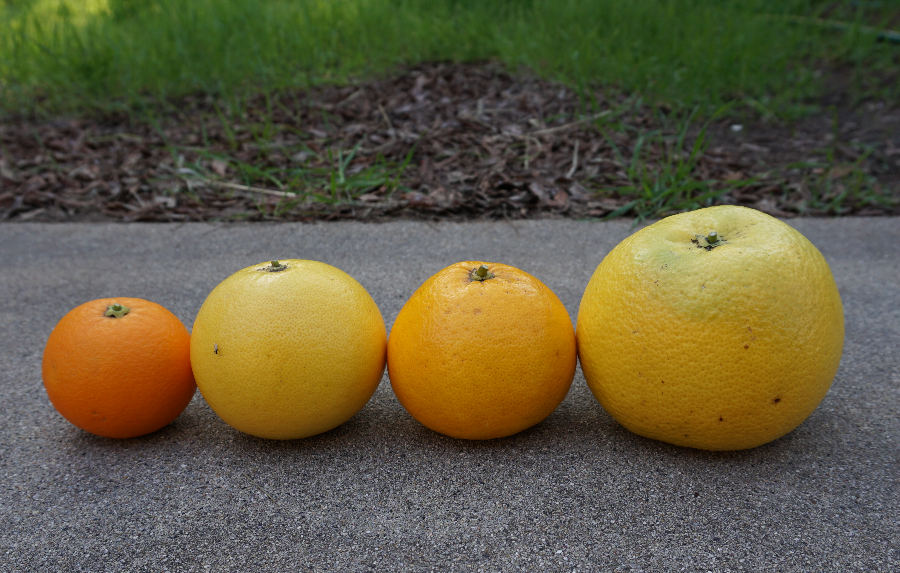
Cocktail grapefruit tree
The Cocktail grapefruit tree is very productive, and its leaves look more like pummelo leaves than mandarin leaves. They have deep green color and small wings on their petioles (leaf stems).
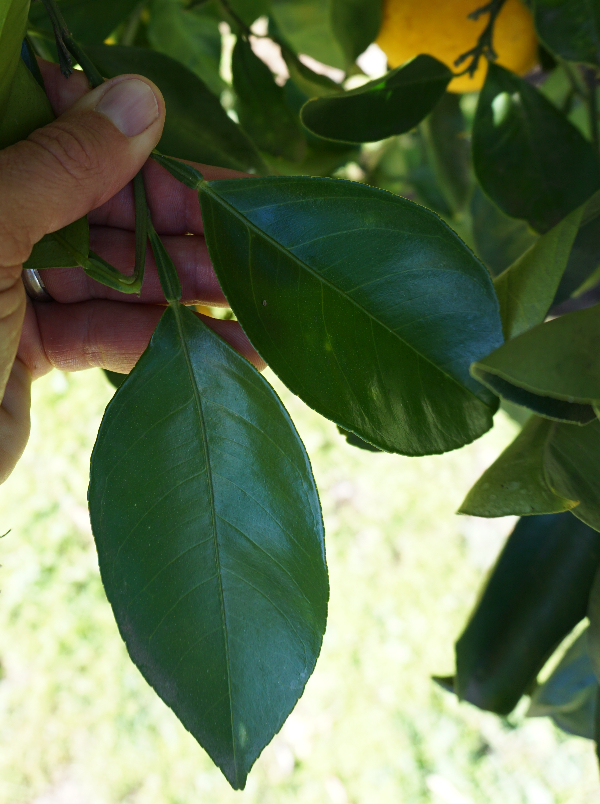
Pummelo leaves have larger wings on their petioles though.

The tree grows almost as fast as a pummelo too. Cocktail trees will be a bit bigger than a mandarin tree of the same age and rootstock.

Where to buy a Cocktail grapefruit tree?
I don’t have a Cocktail grapefruit tree of my own because my neighbor’s is next to our fence. On my side of the fence is a Lamb avocado tree. So we just trade fruit and I have no need for my own Cocktail tree.
But if I wanted to buy one, I would check at my local nursery. If you’re not far from San Diego County, you might try Clausen Nursery in Vista, as numerous people have told me they’ve bought good Cocktail trees there.
Cocktail trees are also available to be purchased online and shipped from the reliable Four Winds Growers. And you can get budwood of Cocktail from the Citrus Clonal Protection Program and graft your own.
In fact, if I ever move or do something to offend my good neighbor, rather than buying a whole Cocktail grapefruit tree I would graft it onto another tree. Cocktails are like cherimoyas for me: I don’t want a whole tree’s worth of the fruit, but my winter feels incomplete if I don’t get to enjoy a few.
Here I enjoy a Cocktail in a video profile of the fruit:
Check out a list of all of my Yard Posts here.
No ads on my Yard Posts because of the direct support of gardeners like you. Thanks!

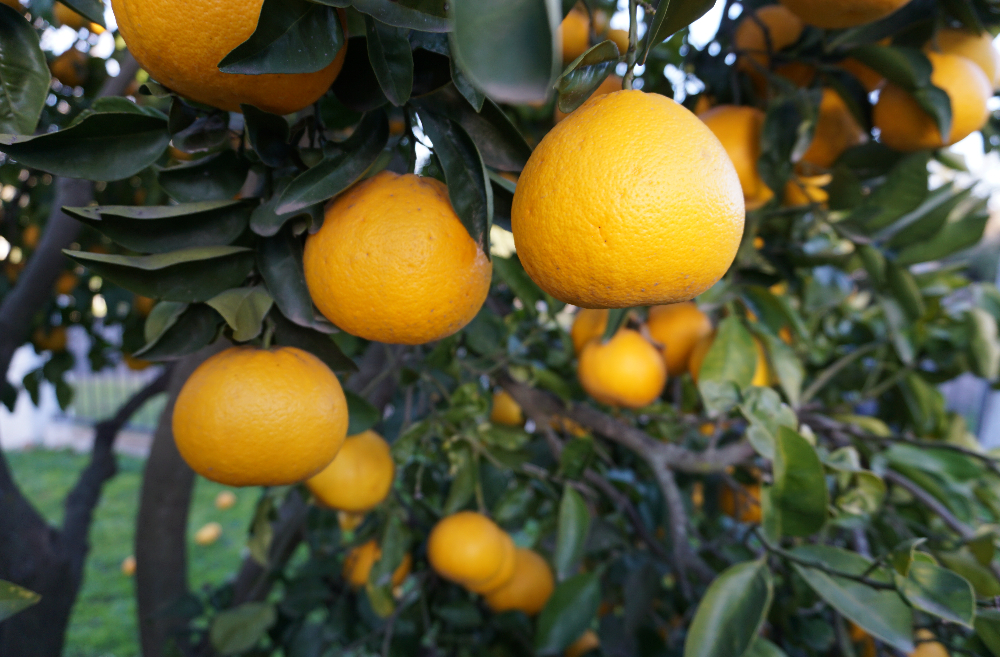


Hi there Greg! Just wanted to add that I have a 4 yr old Valentine pummelo (‘Siamese Sweet’ pummelo x ‘Ruby’ blood orange x ‘Dancy’ mandarin) & it also grows great in SD County, and doesn’t have many seeds at all. Same progression as the Cocktail: from a bit tart in Dec/Jan to sweet as can be by mid-Feb. I juice it with bloods as well for a better sweet-acid balance. I got mine at Four Winds – it grew fast & is super vigorous! I’m considering planting an Oroblanco grapefruit (also pummelo hybrid sometimes called a “sweetie”) which is essentially seedless but which otherwise shares the Cocktail profile & ripeness period. All so much fun!
Hi Holly,
Valentine is a fun variety. It definitely wins for the beauty of its interior.
In terms of flavor compared to Cocktail, I’ve never found Valentine to reach Cocktail’s cloying sweetness. Cocktail gets so intensely sweet that I think a lot of people would find it syrupy and too much. Do Valentines ever get like that? I can’t remember them ever getting like that.
I would love to make a tree with Cocktail, Valentine, Oroblanco, and maybe a pink grapefruit. That would be an awesome tree!
I think I tasted one long ago before I really knew much about citrus varieties and loved it. I was told what I had was probably a Oro Blanco so I found one and planted it. Our whole family love the Oro Blanco and eat them like grapefruit but of course it’s not the fruit I tasted years ago. I recently bought a Cocktail tree grown by Durling and hope that was it, however I may have had another pomelo hybrid, Melogold. Time will tell, and I’m on the hunt for a Melogold too.
Hi Jason,
I once toured the collection at UC Riverside and tried a bunch of grapefruit varieties back to back, which was a nice opportunity for comparison. I just found my notes from that day (early March, 2012). I wrote that Cocktail was different, in a class of its own, with “zero acid.” Of Melogold, Oroblanco, and Ruby Red, I liked them all. It was Ruby Red that had the most acid, and Melogold tasted the best to me. For whatever that’s worth!
I love the Cocktail Grapefruit! I first planted one when I lived in Santa Barbara, then I moved. I now am in SIMI VALLEY and planted another one. It is only a couple of years old but I am looking forward to getting more fruit eventually. For some reason my SB tree didn’t have as many seeds as this one.
I just bought one from my local Lowe’s a few weeks ago
Perfect, Walter! That’s good news. Thanks for sharing.
Hi Vickie,
That’s really interesting about the seeds. I’ve wondered what effect other citrus trees near a Cocktail have on its seed load. Every Cocktail tree I know has a bunch of different citrus trees near them, but maybe a lone Cocktail would have few seeds. I know that some other citrus varieties act like that.
This one did have a tangerine tree near by but that was it.
Hi Vickie,
I also live in Simi Valley (near the hospital) and would love to get a scion off of your Cocktail tree so I could graft it onto one of my other citrus trees. Maybe you would like to take a few scions off of some of my citrus trees to be grafted onto one of your trees. I am retired, so I am available most of the time, whenever it is convenient for you.
Thanx Ken
I got mine Cocktail from Armstrong a year ago. It’s still in container, but already gave fruit.
Hi Greg! I have the EXACT tree/fruit you describe…so sweet, golden yellow skin, full of seeds. Ten years ago I bought my house in Riverside (can see UCR campus from my backyard) from the original owners who bought it in 1972. Rumor was the dad who bought the house originally, was friends with a UCR Citrus Professor who gave him cuttings from one on the original trees. My tree is barely 7 feet tall, pretty round, and produces delicious fruit. I’m in the process of propagating, or grafting, or something in case this bug blight moves into my yard too. Any suggestions?